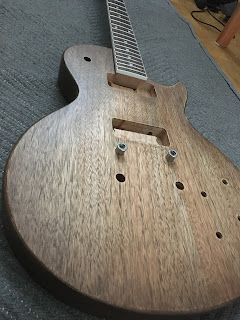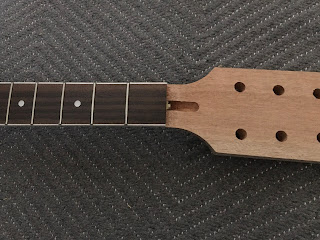The fact is that I own too many guitars. I am not the worst kind of hoarder, I know dudes even in my home town who have like 100+ guitars in their living rooms, but I still have too many considering my actual needs. At the moment, I have a parts-a-caster, two super strats, a Parker Fly, a Warmoth tuned to B, a Les Paul built by my friend, Gibson Midtown and Edwards 335. And the new Les Paul Special. Alone, I have four guitars with P90s installed.
I think that I have been trapped inside some sort of gear addition delusion, where I think that having just another one for the collection is what I need and fills some gap, while actually I don't need anything at all. Owning a humbucker guitrar, a P90 guitar and a guitar with single coils makes sense since they are somewhat non-replaceable. Maybe a guitar with seriously lower tuning than the others could be justified. And if there would be use for something like Filtertrons or Danelectro or similar s needed, that would be ok, but I don't need those for anything. Everything else is just extra, and could be handled by just setting up the amp differently. In the most extreme case you could have one flexible guitar and it would handle everything just fine. Think about Gilmour's strat or Walli's Les Paul for example. I could probably come along with my Warmoth with Duncan P-Rails.
So let's see if I will be able to cut down the guitar department. I already did that with the synthesizers, but ended up getting a sampler and Analog Four, as one of my fried was selling it cheaply. So, actually, that did not go too well. Maybe I will write something about the synths in the future.
However, at the moment I have the following stringed electric instruments:
Superstrat 1: Warmoth parts, SD lil 59s and a no-name single coil in the middle. This is probably the most flexible guitar I have. The tremolo (Wilkinson two point) works great, and the pickup set is really versatile.
Superstrat 2: Squier body, Flaxwood composite neck, SD lil 59 bridge and Duncan Designed single coils. Sounds pretty much the same as the one above, but has a true hot single coil in the neck position
The Black Strat parts-a-caster: Tokai body, Allparts neck, and a mix-up of different pickups just as in Gilmour's black strat. In my scale this one has really vintage and mean sound, and it works extremely well with fuzz pedals.
Warmoth "Les Paul": Bolt on, Warmoth parts with Fender scale. Looks like Les Paul. Tuned to B. This on has really flexible and nice Duncan P-Rails, that sound like humbuckers, P90s and rail single coils. My only baritone-tuned instrument, so this one is a real keeper. And would be worth keeping without the tuning. I think that in normal tuning this is even more versatile than the superstrats.
Handmade Les Paul: My friend built this for me when he was studying to become a luthier. Vintage specs, P90s and really nice neck. What could I say; this truly is a marvelous instrument.
Hosco Kit Les Paul Special: Yeah, this has been discussed. Lighter and thinner than the Les Paul above with easier access to high frets.
Parker Fly Deluxe: Came to me as a part of a trade. The most expensive guitar that I own and in the par with the old Steinberger GM4S I sold a few years back. Good guitar, no complaints. Has DiMarzio humbuckers with split capabilities and piezo pickups, too. I'm not sure if this worth the value. But this is what I think about any expensive guitar, anyway.
Gibson Midtown with BKP P90s: Semi-hollow, thin-neck guitar with high gain P90s. Really nice playability and sound.
Edwards 335 copy with Phat Cats: Semi-hollow, fat-neck guitar with lower gain P90s. Really nice playability and sound. I'm selling this at the moment as the sound is too similar to the Hosco guitar.
Kit built jazz bass: Jazz bass built form German kit with Fender CS pickups. BEAD tuning and my main bass to go.
Ibanez SR505: The jazz bass feels like a tractor in my hands, and this has much sleeker feel to it. Standard tuning with low b in addition. I stripped all the active electronics away.
Carvin LB70: This one has way more growl than the other ones. Think about Geddy in the early 80's. Does not fit into all projects, but if I need a bass that stands out in the mix, this is it.
From the guitars, one super strat, a vintage-sounding strat and any of the P90 guitars would be just fine. From the bass side I guess that the Ibanez would do everything I actually need. The baritone would be a nice addition, but I would be perfectly ok without. If one single guitar should be picked, It would be the Warmoth superstrat or the Warmoth Les Paul, just for their versatility. Parker could probably do also just fine, although it would lack a bit in the single-coil department.
Another thing that I have been thinking is, that there really is no correlation between the price and the quality of the instrument here. I know that an average Squier Affinity does not stand against an average Custom Shop Fender, but in my own collection the price I paid while buying really does not have any correlation with the guitar's value as an instrument. The superstrat 1 is about two times more expensive than the superstrat 2, but really they sound and feel about the same (different but not better or worse) except that one has a different type of neck pickup than the other. The Parker is roughly ten times more expensive than the Hosco LP, but is it any better? I don't think so. I could play stoner rock or doom and the LP would sound better in it. Sure, do some Steve Vai licks and it will be out of the ballpark for the LP (and my fingers, too), but the Parker would feel like home. Of course this has something to do with the fact that I adjust all the guitars to my specifications, so they feel relatively similar in that sense. Yes, I have sold all the guitars that were not good. I have had a dead-sounding Gibson and a twisted-neck Tokai in the past.




































